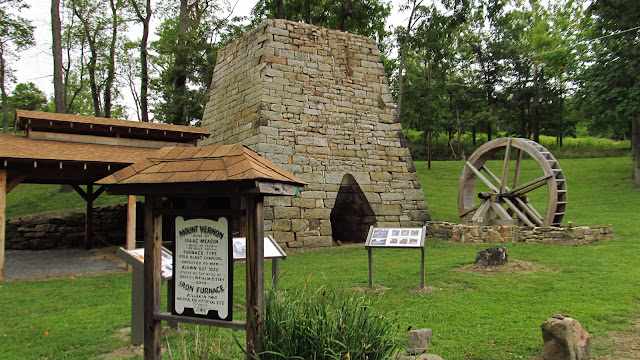Today I drove down to Ohiopyle for their Music In The Mountains festival. It turned out to be a cold and rainy day so I didn't stick around. It also wasn't a good day for trekking through the woods. I decided to drive down to Wharton Furnace and look around there, and on the way home I stopped at the Mt. Vernon Furnace to look at the new signage the Bullskin Township Historical Society just put up. Both sites are incredible examples of restored iron furnaces. Mt. Vernon is especially impressive as the Historical Society has spent a lot of time and effort on the furnace.
Wharton Furnace
Wharton Furnace was in operation from 1839-1873. Construction of the furnace was started in 1837 by Congressman Andrew Stewart. Initially the furnace went out of blast before 1850 and was still abandoned in 1855. The Civil War caused the furnace to be re-fired to produce cannonballs for the Union Army. The site was restored in 1962 by the PA Bureau Of Forestry and the Dept. Of Conservation and National Resources. It was added to the National Register of Historic Places in 1991. Another interesting feature at the site is an iron ingot that was produced by the furnace.
To reach the furnace, take Route 40 east of Uniontown and turn right on Wharton Furnace Road. The site sits at the intersection of Wharton Furnace and Shephard Roads in Farmington.
The following two photos are courtesy of the Fayette County Historical Society
 |
Andrew Stewart, builder of the furnace. |
 |
Wharton Furnace, date unknown, from the 1932 book
|
The following are today's photos:
 |
The arch on the wheel pit side. The vintage photo looks like this side was used for casting. This part is a little confusing to me. |
 |
The wheel pit. |
 |
The hill to the left would be where the furnace was charged from. |
 |
This would be the work arch. |
 |
The large ingot produced at the furnace. |
 |
This is the side that shows the blasting machinery in the vintage photo. |
 |
Closeup of the stonework. |
 |
Looking from the charging side of the furnace. |
Mt. Vernon Furnace
The Mt Vernon Furnace was constructed in 1801 by Isaac Meason. Meason also constructed, among others, the very difficult to access Ross Furnace in New Florence. Like Wharton Furnace, Mt. Vernon was a cold blast, charcoal fueled furnace. Iron produced here was used to make ingots, utensils, kettles and other products. The goods were then carried to Connellsville and shipped down river. Some going as far as Louisiana. The furnace went out of blast in 1830. It was placed on the National Register of Historic Places on September 6, 1991. Since 1996, the Bullskin Township Historical Society has been doing an incredible job preserving the furnace and collecting artifacts related to its history. They also keep a small museum on site with limited hours. See their website for more information.
To reach this furnace take Route 982 North off Route 119 at the Sheetz. Go about four miles and make a right on Eutsey Road. Turn right on Park Road and the furnace is right there.
 |
The incredibly restored Mt. Vernon Furnace. To the left is a restored casting house. |
 |
A beautiful place to visit. |
 |
The new interpretive signs. |
 |
The restored casting house. |
 |
The furnace was charged from the hillside on the right. |
 |
The charging side of the furnace. |
 |
The work arch from inside the restored casting house. |
The following are some more older photos of these two iron furnaces. Photos and drawings courtesy of Ray Washlaski.
 |
Wharton Furnace |
 |
Wharton Furnace. Visible in this photo are the charging house, bridge house, mechanical blast equipment and portions of the wheel house and casting house. |
 |
Wharton Furnace drawings by Ray Washlaski |
 |
Mt. Vernon Furnace prior to restoration. |
 |
Mt. Vernon Furnace in the 1800's. |












